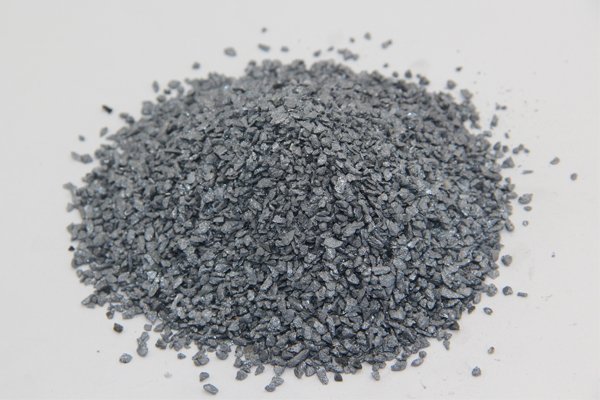1. 75 ferro silicon
Ferro silicon is a commonly used inoculant. The content of aluminum and calcium in it plays an important role in the inoculation effect. It is reported that ferro silicon without aluminum and calcium has little or no effect on inoculation of gray cast iron. It is generally believed that in molten iron, aluminum and calcium will react with oxygen and nitrogen to form compounds with high melting points, which will become the core of stone crystallization. Moreover, after adding the inoculant, local silicon-rich micro-regions can be formed in the molten iron, which is beneficial to the precipitation of graphite. When purchasing ferro silicon for inoculation, the content of aluminum and calcium should be considered. For 75 ferro silicon used as inoculant, the upper limit of aluminum content is 0.5%, 1.0% and 1.5%, respectively, and the upper limit of calcium content is 1.0%. However, the aluminum content in the molten iron should not be too high. Adding 0.01% aluminum may cause subcutaneous pores in the casting.
2. Silicon barium alloy
Silicon-barium alloy as inoculant can significantly reduce the whitening tendency of cast iron, and can increase the time to maintain the inoculation effect to about 30 minutes, especially suitable for large castings. When processing, the amount of alloy added is about 0.1
 3. Calcium silicon alloy
3. Calcium silicon alloy
Although silicon-calcium alloy has a strong inoculant effect, it is not suitable to use granular alloy as an inoculant for cast iron except for the application of cored wire. Its main disadvantage is
◆The density is much lower than that of molten iron, which is easy to float and affect the relationship between it and molten iron
◆Inoculation effect declines quickly
4. Rare earth inoculants
Rare earth mixed metals and rare earth ferro silicon and other inoculants containing rare earth metals, when added properly, have a strong inoculation effect, and their effect is several times that of 75 ferro silicon, which can effectively eliminate whitening and slow down the decline of inoculation. . If the amount added is too high, it may cause supercooling and cementite structure when the cast iron crystallizes, so the amount must be strictly controlled during use.
5. Carbonaceous inoculants
Carbonaceous inoculants are mainly used for pretreatment before inoculation of molten iron, and are generally crystalline carbonaceous materials. According to a research report, for gray cast iron, 85-90% metallurgical silicon carbide has a better effect, and crystalline graphite is also effective. The amount added during pretreatment is generally 0.75~10%, and a better value should be obtained according to the test results.
Ferro silicon is a commonly used inoculant. The content of aluminum and calcium in it plays an important role in the inoculation effect. It is reported that ferro silicon without aluminum and calcium has little or no effect on inoculation of gray cast iron. It is generally believed that in molten iron, aluminum and calcium will react with oxygen and nitrogen to form compounds with high melting points, which will become the core of stone crystallization. Moreover, after adding the inoculant, local silicon-rich micro-regions can be formed in the molten iron, which is beneficial to the precipitation of graphite. When purchasing ferro silicon for inoculation, the content of aluminum and calcium should be considered. For 75 ferro silicon used as inoculant, the upper limit of aluminum content is 0.5%, 1.0% and 1.5%, respectively, and the upper limit of calcium content is 1.0%. However, the aluminum content in the molten iron should not be too high. Adding 0.01% aluminum may cause subcutaneous pores in the casting.
2. Silicon barium alloy
Silicon-barium alloy as inoculant can significantly reduce the whitening tendency of cast iron, and can increase the time to maintain the inoculation effect to about 30 minutes, especially suitable for large castings. When processing, the amount of alloy added is about 0.1

Although silicon-calcium alloy has a strong inoculant effect, it is not suitable to use granular alloy as an inoculant for cast iron except for the application of cored wire. Its main disadvantage is
◆The density is much lower than that of molten iron, which is easy to float and affect the relationship between it and molten iron
◆Inoculation effect declines quickly
4. Rare earth inoculants
Rare earth mixed metals and rare earth ferro silicon and other inoculants containing rare earth metals, when added properly, have a strong inoculation effect, and their effect is several times that of 75 ferro silicon, which can effectively eliminate whitening and slow down the decline of inoculation. . If the amount added is too high, it may cause supercooling and cementite structure when the cast iron crystallizes, so the amount must be strictly controlled during use.
5. Carbonaceous inoculants
Carbonaceous inoculants are mainly used for pretreatment before inoculation of molten iron, and are generally crystalline carbonaceous materials. According to a research report, for gray cast iron, 85-90% metallurgical silicon carbide has a better effect, and crystalline graphite is also effective. The amount added during pretreatment is generally 0.75~10%, and a better value should be obtained according to the test results.
Contact Us Today!
We welcome inquiries in English, Español (Spanish), Русский язык (Russian), Français (French), and العربية (Arabic).
Our professional team will reply to you within one business day. Please feel FREE to contact us!
Your privacy is important to us,we are committed to marking sure your privacy is
confidential.
